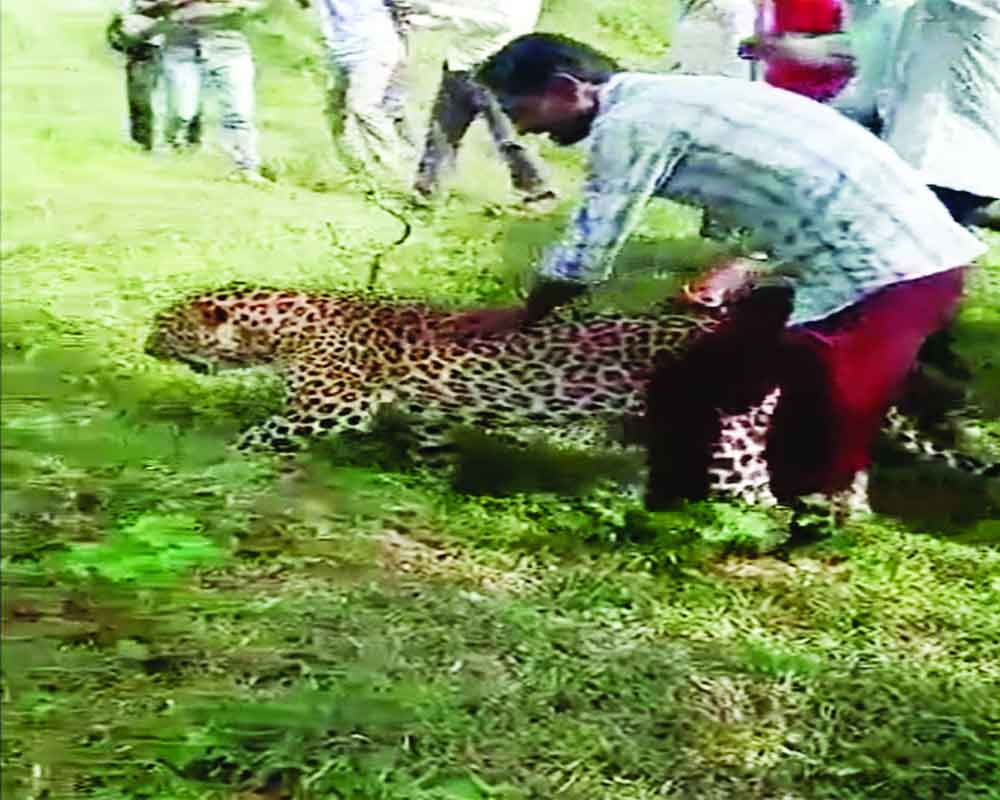From the dangers posed by selfie-seeking citizens in Telangana to the heartbreaking instances of being beaten in human-animal conflict in the national capital, rapid urbanisation, and the ruthless poachers across the States, leopards in India seem to be on the run for their life. Road accidents are also becoming a significant cause of leopard fatalities in the country.
India has lost 137 leopards in just two months and ten days this year alone. Among these casualties, a staggering 32 majestic cats fall victim to the poachers, according to data available from the website of the Wildlife Protection Society of India (WPSI).
This is quite high, given that in calendar year 2023, a total 565 leopards had succumbed to various causes with 155 trapped by poachers to earn quick bucks in the international market.
The disturbing data comes amid a report released by the Union Environment Ministry that has suggested the leopard population has witnessed a marginal increase to estimated 13,874 leopards, up from 12,852 in 2018, even as human-leopard conflicts remain a major worry.
“The data shows that the leopard population hasn’t grown the same way the tiger population has grown. It is a marginal increase,” Wildlife Institute of India’s (WII) former dean YV Jhala told a media house.
However, he said since leopards remain enticing targets for poachers, “it is a matter of satisfaction to manage the status quo”.
In Telangana majestic leopards faced a grim fate, marked by tragedy and sorrow when an ill-fated animal was captured in videos by locals from Kansanpalli of Damaragidda mandal. In these recordings, the young leopard appeared visibly unwell, yet this did not deter the locals from pursuing it in a misguided attempt to capture selfies with the wild creature.
In fact, at the heart of the issue lies the relentless encroachment of human civilisation into leopard territory. As forests are cleared for agriculture, industry, and urban expansion, the natural habitats that sustain leopard populations are shrinking at an alarming rate.
Wildlife experts said increasing territorial fight among tiger and leopard in many tiger reserves also threatens their existence.
This has left the spotted cats with fewer places to call home.
In rural areas, where subsistence farming and livestock rearing are livelihood mainstays, leopards often find themselves in direct competition with humans for resources.
Instances of leopards preying on domestic animals provoke retaliatory killings by enraged villagers seeking to protect their livelihoods, further escalating tensions and perpetuating a cycle of violence that further endangers these majestic predators.
For instance, on February 13 in Udaipur, six persons were injured in a leopard attack in Antri forest area in Dungarpur. Irate villagers later surrounded the leopard and beat it to death with sticks and stones. The incident took place in Upala Ghara Nokna of the interior forest area. The leopard first attacked cattle tied outside the houses.
Stalin Dayanand, director, Vanashakti, a non-profit organisation, took exception that roads are being built right through leopard corridors without giving a thought.
“Roads have come up cutting right through wildlife sanctuaries like Tansa, Tungareshwar or even the SGNP thus blocking seamless movement for the leopards.
“How is a leopard to know if a structure suddenly turns up on his path that naturally and instinctively leads it to the next forest? He will continue frequenting that area” he said matter-of-factly.
The experts also found fault in policy related to the release of leopards after being caught in conflict. They cited various studies that show that they rarely stay at the site of release. In fact, according to them, the policy of trans-locating leopards to other forests has enhanced the conflicts.
“Leopards which had been cohabitating peacefully with villagers started attacking people when they were released far away from their territory,” said Vidya Athreya, scientist with the Wildlife Conservation Society-India (WCS-I).
“This was likely due to the stress they faced during capture, release in an unknown area. We also found many instances of translocated leopards homing back to where they were originally caught,” she added.
“If the leopard has been captured only because it has been seen, it is best to release it as close as possible to its territory because we have management evidence that there is no problem later,” she advised, adding that the feline is very adaptable and therefore it is possible for them to live in rural landscapes, and eat domestic animals, dogs, and even rats.
In Delhi too, a male leopard was subjected to a brutal attack by a mob from Deoli village, adjacent to Sainik Farms, even as it was silently making its way towards its natural habitat.
Despite the efforts of the State Animal Welfare team to tranquilise the animal, the situation turned dire as stones were hurled at the leopard by the enraged mob. The Animal Welfare team found themselves under attack as the mob fiercely opposed the rescue efforts, expressing their intent to kill the animal.
Experts also point out that growing demand for leopard skins and body parts in international wildlife markets is driving poachers to target these animals.
“The illegal international demand for big cat skins along with the trade in bones and other parts for use in traditional oriental medicine, continues to be the main reason for the unrelenting poaching pressure on these endangered cats. There is virtually no market for either skins or bones of leopards within India,” according to an official from the WPSI.
The Government report speaks volume about the decline in leopard populations in a few regions like Shivalik Hills and Gangetic Plains which were once brimming with the majestic cats. The regions have respectively recorded a worrying 3.4 per cent per annum decline, going down from 1,253 in 2018 to 1,109 in 2022.


























